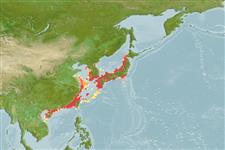>
Tetraodontiformes (Puffers and filefishes) >
Tetraodontidae (Puffers) > Tetraodontinae
Etymology: Takifugu: A Japanese word with several meanings; taki = waterfall + fugu = fish; it could be also understood as taki = to be cooked in liquid + fugu = a venomous fish.
More on authors: Jordan & Snyder.
Environment: milieu / climate zone / depth range / distribution range
Ecologia
marinhas demersal. Temperate
Northwest Pacific: Japan and southern Korea to Vietnam (Ref. 46893).
Tamanho / Peso / Idade
Maturity: Lm ? range ? - ? cm
Max length : 15.9 cm TL macho/indeterminado; (Ref. 125279); peso máx. Publicado: 83.30 g (Ref. 125279)
During high tide, mature individuals swim ashore in large numbers and spawn on beaches. Eggs are left partially buried in sand and rubble (Ref. 240).
Life cycle and mating behavior
Maturidade | Reprodução | Desova | Ovos | Fecundidade | Larvas
During high tide, mature individuals swim ashore in large numbers and spawn on beaches. Females spawn on the surface with two or more males biting and hanging on to the ventral surface of each female. Eggs are left partially buried in sand and rubble (Ref. 240).
Masuda, H., K. Amaoka, C. Araga, T. Uyeno and T. Yoshino, 1984. The fishes of the Japanese Archipelago. Vol. 1. Tokai University Press, Tokyo, Japan. 437 p. (text). (Ref. 559)
Categoria na Lista Vermelha da IUCN (Ref. 130435: Version 2024-2)
Ameaça para o homem
Poisonous to eat (Ref. 9137)
Utilização humana
Pescarias: de interesse potencial
Ferramentas
Relatórios especiais
Descarregue XML
Fontes da internet
Estimates based on models
Preferred temperature (Ref.
123201): 17.1 - 26.6, mean 23.6 °C (based on 116 cells).
Phylogenetic diversity index (Ref.
82804): PD
50 = 0.5000 [Uniqueness, from 0.5 = low to 2.0 = high].
Bayesian length-weight: a=0.01862 (0.01461 - 0.02374), b=2.91 (2.84 - 2.98), in cm total length, based on LWR estimates for this species (Ref.
93245).
Nível Trófico (Ref.
69278): 3.3 ±0.44 se; based on food items.
Resiliência (Ref.
120179): Elevada, tempo mínimo de duplicação da população menor que 15 meses (Preliminary K or Fecundity.).
Fishing Vulnerability (Ref.
59153): Low vulnerability (10 of 100).
